This resource celebrates the creative work by secondary and tertiary students who responded to the exhibition through imaginative writing and musical composition.
Teachers Notes
-
Secondary students' interview with Dr Angela Hesson
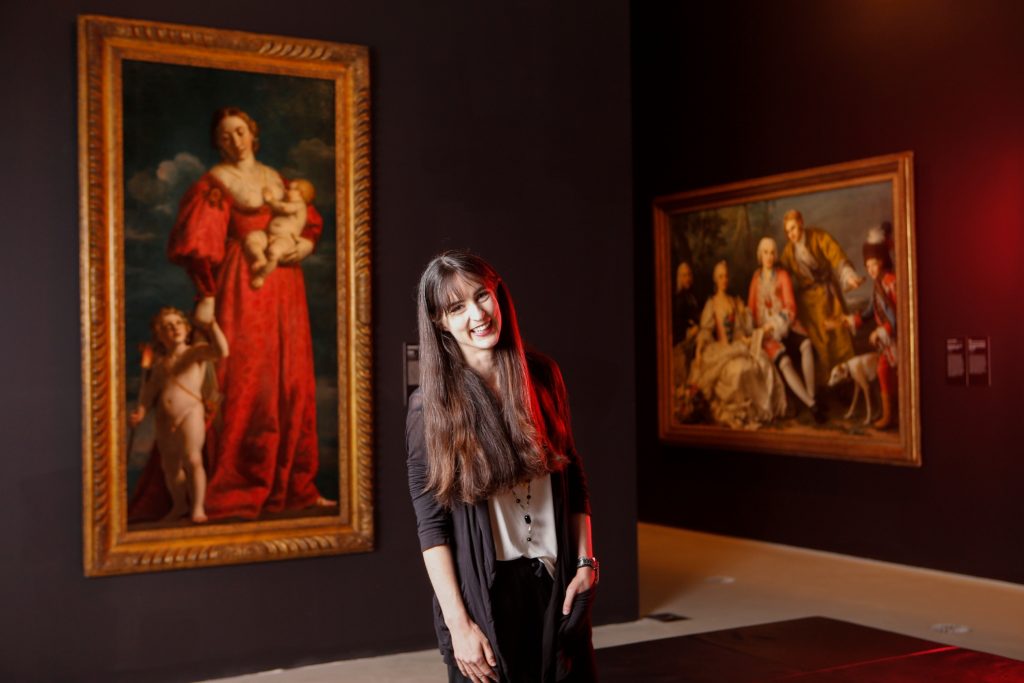
Angela Hesson CHE appointment Curator Love Art of Emotion 1400-1800Love: The Art of Emotion 1400 – 1800 explored the many types of love including familial, religious, materialistic, patriotic and narcissistic as seen through the eyes of artists working in the early modern period.
To discover how young people living today might respond to ideas about love from this period and how they may have changed in today’s world, three Year 9 students from Princes Hill Secondary College were invited to explore the exhibition and interview the curator Angela Hesson about the issues and ideas that were raised for them.
Secondary: Young Writers Festival Program — May 2017
In May 2017, fourteen passionate writers in Year 9/10 from a range of educational contexts visited the NGV for a three day creative writing program.
Inspired by works in the exhibition, (Love: The Art of Emotion, 1400-1800) and mentored by the curator Dr Angela Hesson and three professional writers, Tony Thompson, (Novelist), Lucy Van, Melbourne University,(Poet) and Dr Mark Nicholls, Melbourne University, (Film script writer), the students created the following highly individual responses which illuminate the power of art to inspire vivid imagery and creative thinking.
Each response below is listed under the student’s name along with the artwork that inspired their creation.
Atticus — Princes Hill Secondary College
You, 2017
I can no longer beat it.
I cannot bear to no longer see your face, to hear your voice, to feel your hand on my cheek.
You were my guardian, my protector, you were mine and I was yours. And you just left me here, alone, afraid, unprotected.
How cruel, you come bringing the light and fire into my life but then blow it out.
And you expect me to stay here? Here, where there is no fire, no light, no you, only darkness, pain and sorrow.
If I did not love you I would bring you back, only to make you feel my pain, my sorrow, my hardship.
I would destroy the world and everything in it, just so I could see your face, hear your voice, feel your hand on my cheek. Forever.
I can no longer bear it.
Danny — Albert Park College
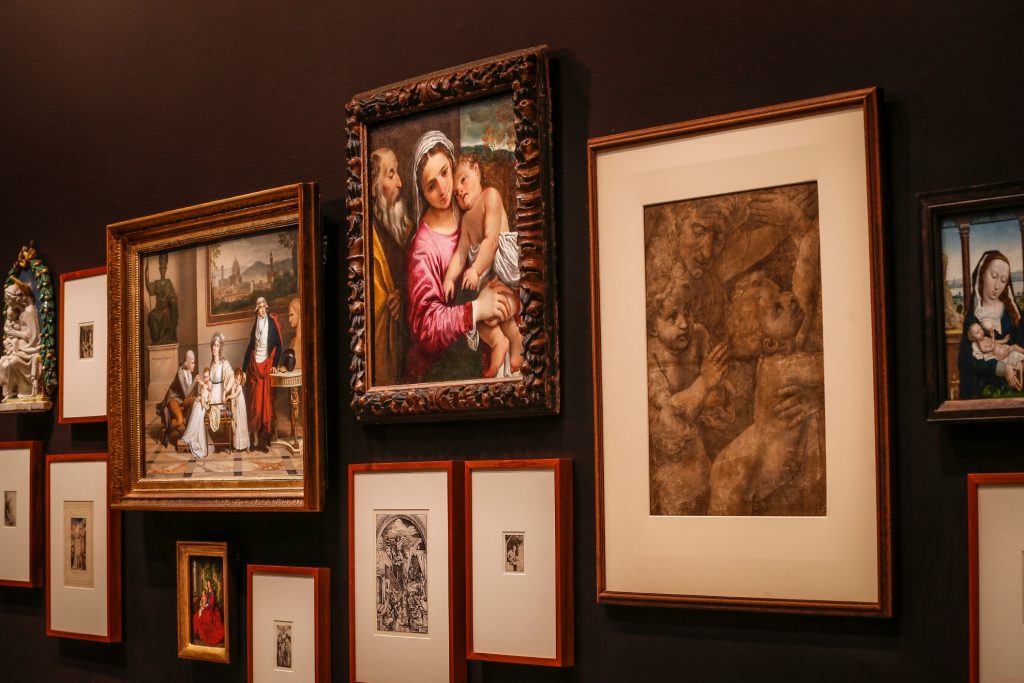
Installation views. Love: Art of Emotion 1400 – 1800
Untitled, 2017 (Inspired by the whole exhibition)
You like me because I look like a rainbow,
One with colours that blind you,
One with colours that mesmerize you,
But then you learn,
That down below Deep down,
Where no one lurks,
There is a hurricane.
And you are unable to control it.
What happens then?
But what if you learn,
The very hurricane
Staring you right In the eyes, Is the very reason behind the passion and desire,
For your very arms?
And what if you learn,
That the fire coming from within my soul,
Is the fire that drives me,
Drives me to throw myself at you,
Drives me to give you everything I have,
Just to get a piece of you?
Would you be frightened?
Danny — Albert Park College
The Woods, 2017
The woods that once by fate alone,
Conceived and birthed our love.
A sweet cacophony of sound,
Did play with our new found fate.
But now you’re gone,
This forest haunts me.
Insects, bugs and roaches
But ahh that pendulum did swing,
Swing back to me with luck and glee.
Now I have found a new love,
In this colony of caverns,
This collection of crevasses.
I could trace the walls for hours.
Though love did claim another victim.
And as I fell I knew it well.
That I had died as you did.
Gabrielle — Kilvington Grammar School
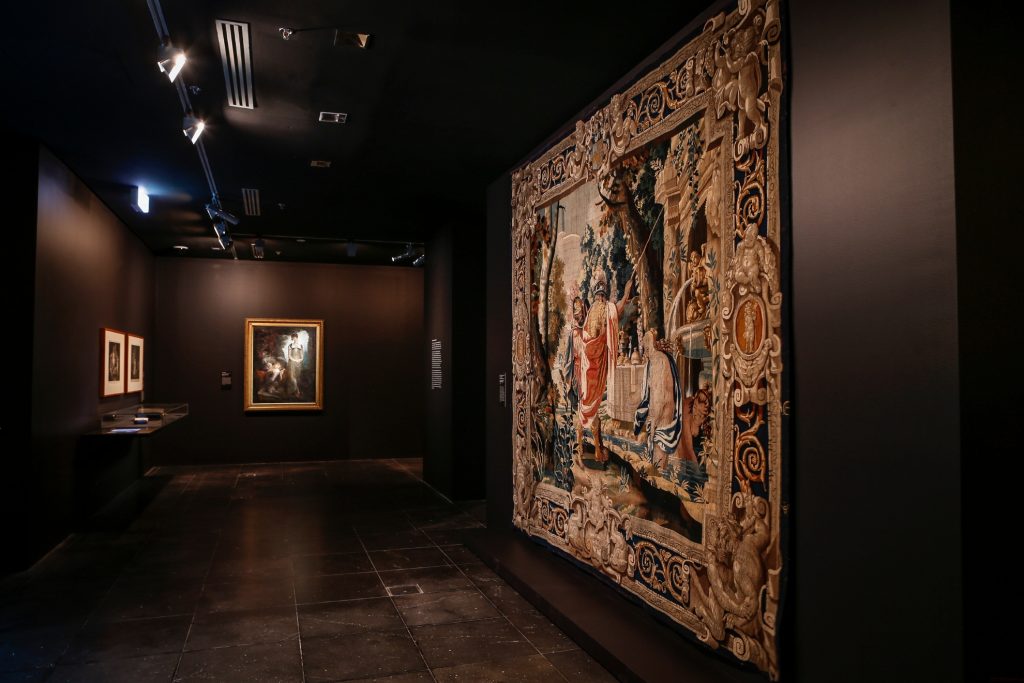
Installation views. Love: Art of Emotion 1400 – 1800
Want, 2017 (Inspired by the whole exhibition)
What could this be
Etched into my skin
It sinks into my bloodstream
Heavy relentless viscous wolf predator all consuming colossal jaws
Something more
More or less
The silent presence of absence takes up more space than you ever did
Undone shoes kiss familiar streets but my house is but home
Home is 6 feet of ruthless intelligence flesh on flesh tracing freckles into constellations
Narcotic co-dependency craving more
Let it consume me devour me snap me back together
Can you make me whole?
The wanting comes in waves
Car crash violent thought stealing flesh ripping consumption
My body is a consumerist society and the currency is sin
Second hand smoke like a wreath around my ribcage
Let the hypertension become secondary
The metallic tang never remains sedentary
Violets wilt in
Flesh carved hollows
Cavity expansion let it crumble
Vice grows out of the ashes
The silence turns violent
Nhung — St. Albans Secondary College
Untitled, 2017
My silk white dress and shaking palms meet with your comforting gaze as you watch me longingly from down the aisle on our wedding day.
You share with me now two words and a vow and I share with you a world once mine and now yours.
Olivia — Williamstown High School

Installation views. Love: Art of Emotion 1400 – 1800
Heart thief, 2017 (Inspired by the whole exhibition)
Blinding rage burning bright,
I hunt you with all my might,
For a terrible crime you committed,
And now your life is forfeited.
It was a pulsing living thing you stole,
Its body buried deep below,
Churning yearning feelings stop,
As you make the unlawful swap.
A precious thing has been traded for gold,
Something no man should behold,
Upon you I set my unwavering gaze,
It is your soul I shall raze.
Olivia — Williamstown High School
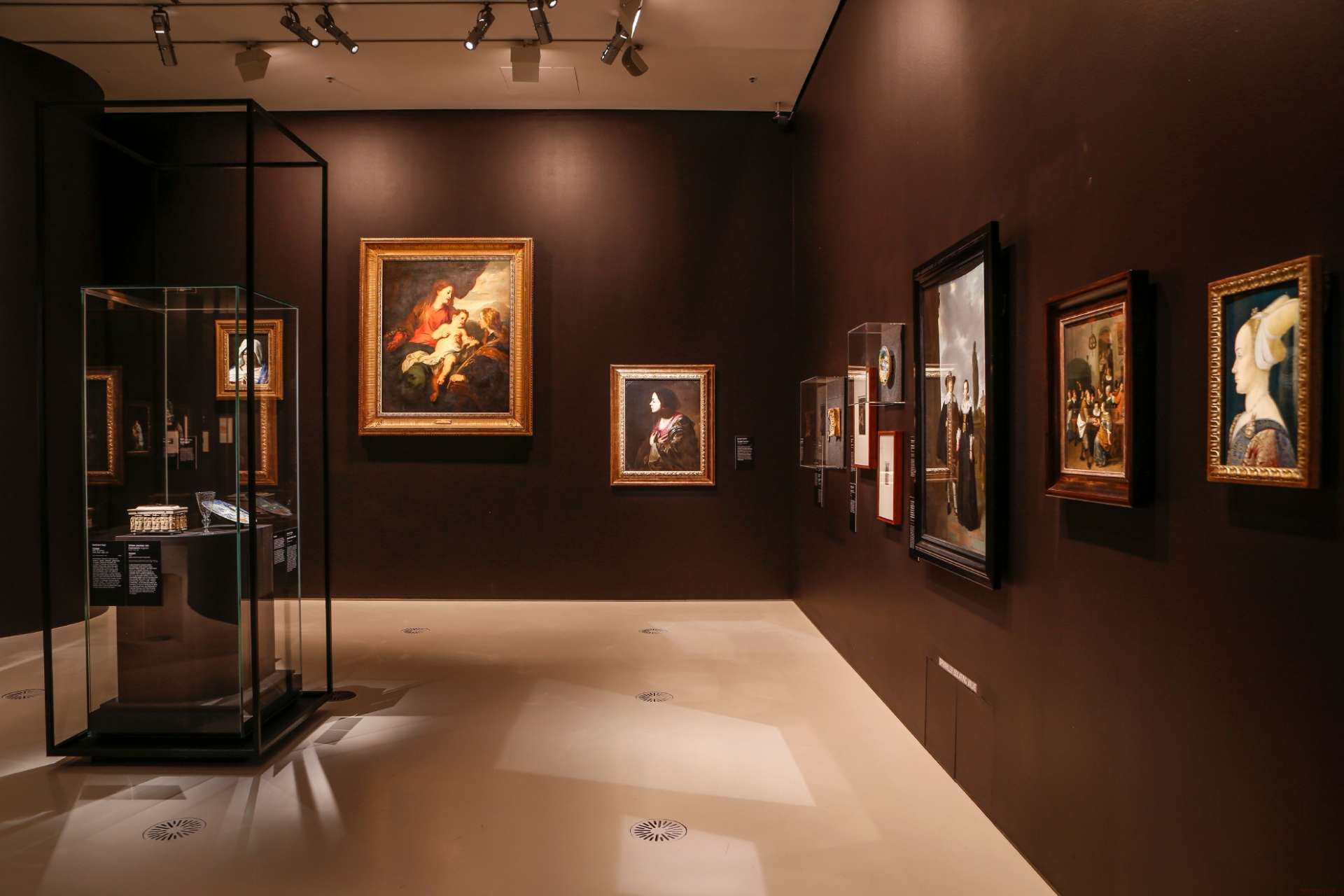
Installation views. Love: Art of Emotion 1400 – 1800
Leaving, 2017 (Inspired by the whole exhibition)
When you first appeared I held you in my arms,
Swearing to always protect you from harm,
Yet as time turned minutes to years I became depressed,
And the next day you left.
Olivia — Williamstown High School
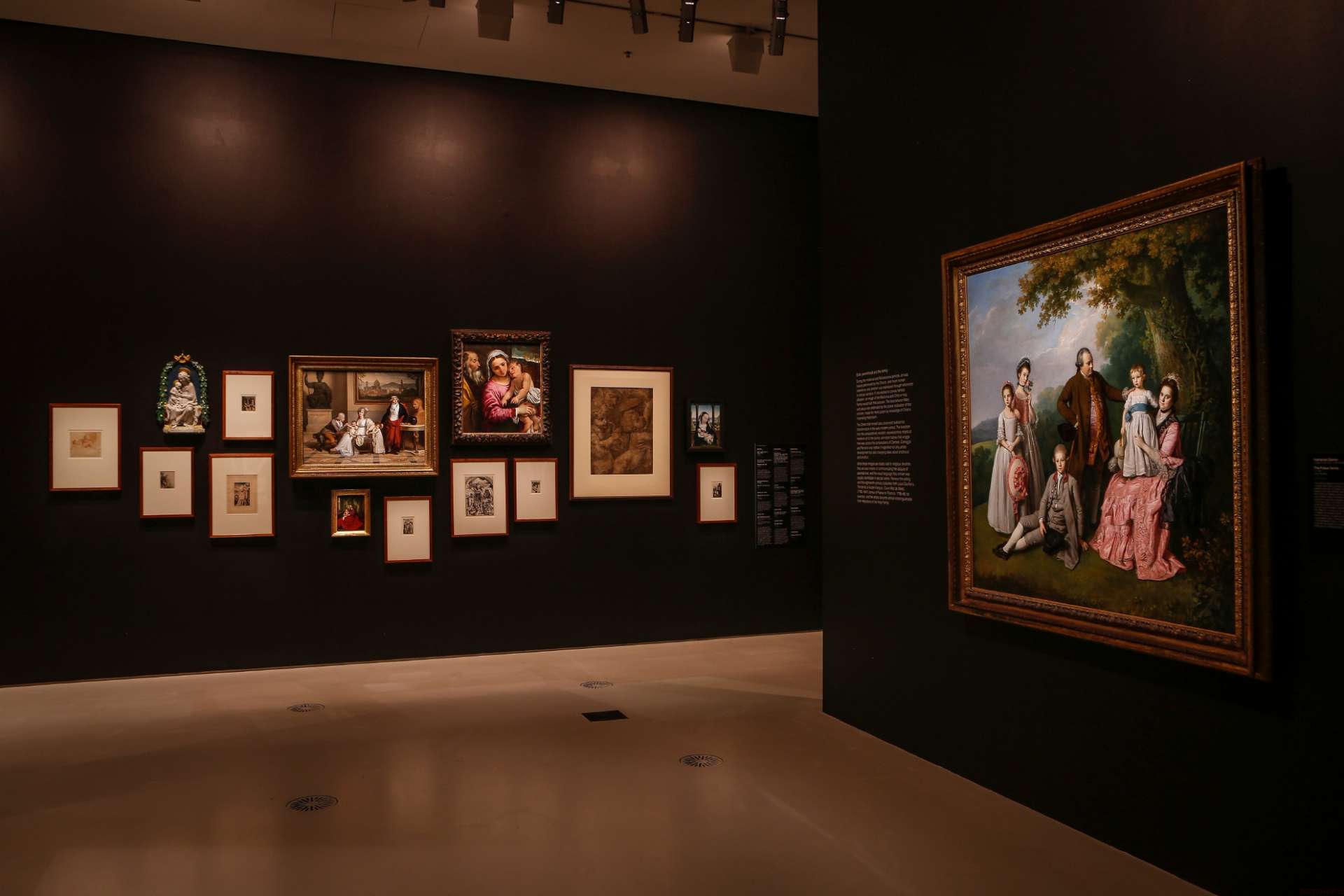
Installation views. Love: Art of Emotion 1400 – 1800
Beauty, 2017 (Inspired by the whole exhibition)
Behold, behold,
This trembling beauty,
Sweeping planes of skin,
Woven locks of black.
A soulful gaze,
Lowered head,
Lidded lashes,
Body on bed.
Soft flesh,
Hard bones,
Fluttering fingers,
Low tones.
Smooth movements,
Quiet words,
Empty promises,
Flying like birds.
Shining face,
Dirty hands,
Loud cries,
She is grand.
Burning warmth,
Filled hearts,
Behold, behold,
This girl of art.
Natasa — St. Albans Secondary College
Untitled, 2017
A cream dress’s simplicity
Defies our present necessity.
Once was composed of patterns so bright
Is now predominantly stained of pure white.
An eventful day it is for me
Walking in a dress oh so silky.
My beloved husband-to-be shall be my guide,
In which today he will make me a joyful bride.
Joe — Albert Park Secondary College
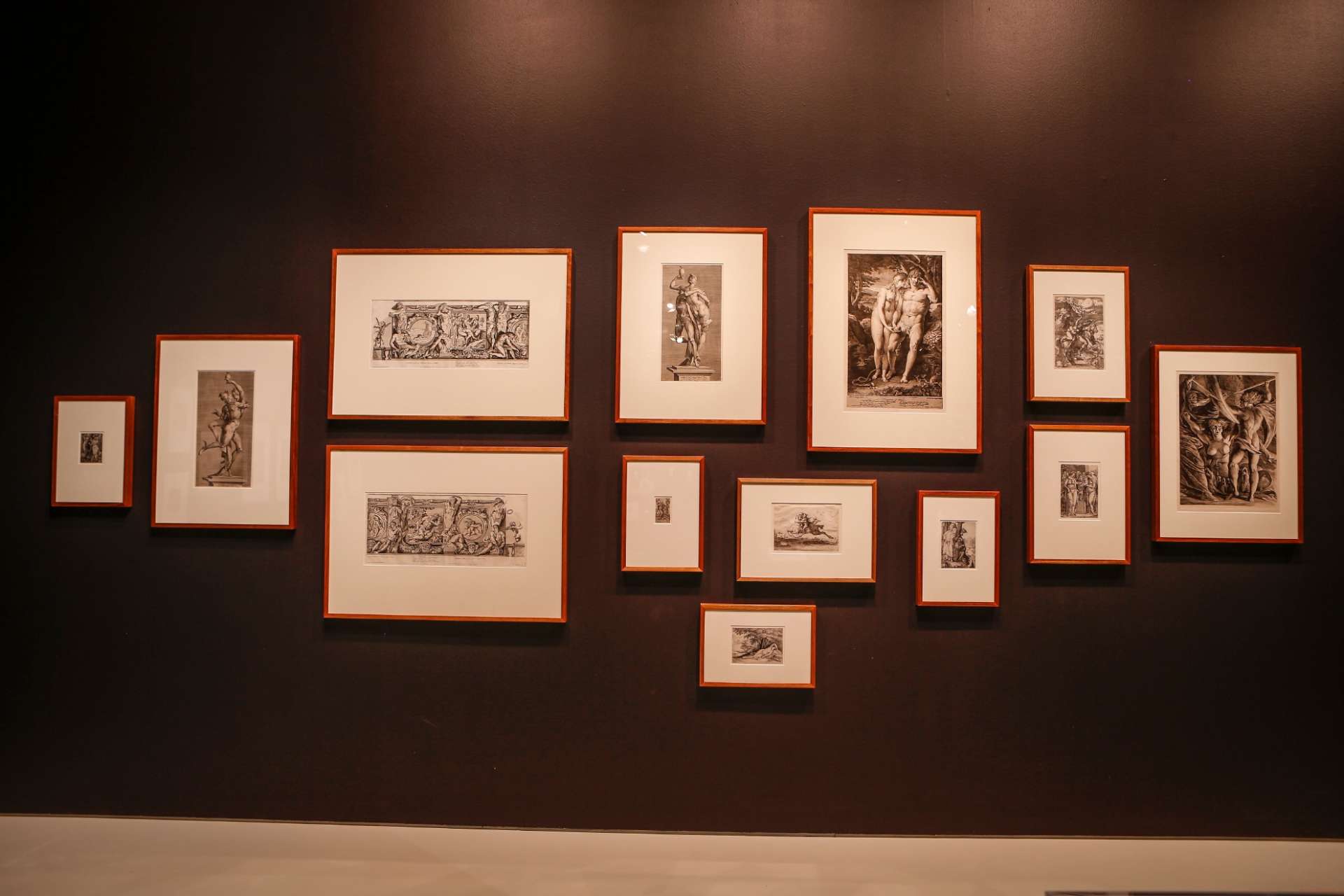
Installation views. Love: Art of Emotion 1400 – 1800
Dumb Love, 2017 (Inspired by the whole exhibition)
I don’t know why we want dumb love.
Maybe it’s the movies, what we see in the world,
The rappers who romanticise an ugly, angry youth,
All those who try to tell us, “love only ever ends”.
No love stories end happily, riding into the sunset.
They end with loss and leaving, one more dead Juliet.
Rom-coms try to that tell us a break up is the start,
But no grand romantic gesture, will fix what falls apart.
Hollywood and Abbey Road, all tell us it should end,
Broken hearts top charts, and so the story goes.
We now believe the life to lead,
Is paved in dead romance.
So I say love!
Screw those who try to tell us the heart is in the end,
All those who romanticise dumb angry useless men,
Or all those girls who break and break and never see the end.
We are strong, we know better,
We know love holds us together.
Say it now, say it proud,
We don’t want dumb love.
Amy — Princes Hill Secondary College
Waiting, 2017
I had forgotten you weren’t beside me
That I couldn’t hear you soft breath against my skin
Without your silent presence
I felt cold
I walked across dark silence
As the distance grew, my body fell
Numb and broken, no words escaped
My lips
I felt no feelings
They were brushed away, replaced
The moon kissed my tired feet, I waited
Right at the top
I can’t wait any longer for you
You knew I couldn’t stay forever
You knew I would eventually fall
down
down
down
down
down
down
down
down
down
faster
faster
faster
faster
faster
right
to
the
ground
Nellie — Princes Hill Secondary College
The statue of Aphrodite rose from a base of waves; illuminated under the sun. The marble defrosting from pearl white to butter yellow. Eyes of marble sweep but do not see the courtyard filled with bright gowns and the invasive babble of guests. Solid limbs of white stretch in a sweep to encompass the scene. The guests disperse to fill the cobbled streets with chatter. The party had weaved through the afternoon as a colourful haze. The supply of champagne had been drunk to the last drop and now nothing is left to entertain the aristocrats enough to stay.
Five remain as the sun echoes the gold vein running through Aphrodite’s gown. The two hosts, Lady and Lord Picot, stand to the left of the fountain; bedecked in embroidered gowns frothing with lace. Their maid is sewing by the fountain, relinquishing the shade cast down from the statue. Two friends of the hosts, Lady and Lord Burdett, gossip in the dappled light of the high peach trees. They are alike to their hosts in their finery and manners but their chatter strays to opposing sides of the fountain.
As the sun spills over the churning waves and trickles off the doves’ wings at Aphrodite’s base, the prattle of each couple halts and they share conspiratorial glances. The scent of bloomed peaches masks that of the poison dosing Lady Burdett’s scarf, poured from a crystal bottle revealed from the folds of her gown. Lord Burdett hides her misdeeds with his hat, raised to the beauty of Aphrodite.
All that the maid heard was a muffled breath, like that of a flame quenched of oxygen. She saw the moment that death glazed over Mr Picot’s eyes as it rippled across the pool of water by which she stitched. In shock the maid turns toward Lady Picot, only to find her passed out at the base of a peach tree. Red lines, the ghosts of fingers, encase the column of her neck. Under the rise of her chin the impression of a ring is branded. Lord Picot’s seal cuts into her breakable neck.
Ever since her wedding day, drowned in white frills and gifts, Lady Burdett has loathed Lady Picot, despised her opulence. Lady Picot had had a nerve to turn up at the paltry country town church dressed in Sunday attire with a devoted Lord Picot clinging to her arm. Interrupting the maudlin ceremony to wish the couple a happy future in her shrieking voice. The wish became a curse in years to come as Lord Burdett’s estate fell to ruin and Lord Picot’s rose. It was no difficulty to coerce Lord Burdett into completing the murder; he simply hated being outdone.
The richest man in society swearing oath to her and still Lady Picot shadowed Lady Burdett. Inviting her to every party to flash her supremacy and her charming children who were schooled to the apex of their extent. Her shadow cast a taunting power over the Burdetts all their lives.
Lady Burdett now holds inevitable power in her hand, more precious than any Lady Picot ever possessed. She places the poison soaked scarf that ended a life to her own porcelain face. Aphrodite saw it all with a cold and unflinching gaze, condescending from above the tamed peach trees, arms outstretched to the fading sky.
Tertiary: Sounding Out ‘Love: Art of Emotion’
Drawn from blog entry Sounding Out ‘Love: Art of Emotion’, June 9, 2017 by Dr Anthony Lyons, The University of Melbourne
Dr Anthony Lyons is a composer, academic and lecturer in Interactive Composition at the Melbourne Conservatorium of Music, Faculty of the VCA & MCM at The University of Melbourne.
In 2017 a number of students from The University of Melbourne’s Interactive Composition program engaged with the exhibition ‘Love: Art of Emotion 1400–1800’, a collaboration between The ARC Centre of Excellence for the History of Emotion, University of Melbourne and the National Gallery of Victoria (NGV). The student involvement spanned over three weeks and resulted in the creation of over 30 new sound compositions directly inspired by the exhibition curated by Dr Angela Hesson.
While creating new compositions to visual artworks is certainly something the students have done previously, the historical dimension to the ‘Love’ exhibition was a new experience for many. There were no living artists to collaborate with or ask about their artistic intentions. This put the onus on the composer to make their own interpretations and explore their own emotional responses to the artworks that most resonated with them.
Many students seemed to have made connections with artworks by personalising their response, by putting themselves into a narrative, or empathising with a character or situation portrayed in an artwork.
Each student’s work displays depth and diversity of emotional states. The strong emotional responses speak volumes about the inner feelings, thoughts and ideas of the composers, with the exhibition artworks perhaps acting more as provocations to ignite and focus aspects of individual emotional exploration. Taken as a contemporary snapshot of young creators, these audio works map a unique sense of time and place based around creative and emotional engagement with the exhibition Love: Art of Emotion 1400–1800.
Each sound piece is approximately four minutes duration, and range from instrumental acoustic pieces to a number of song-based works, to the electronic. They are also stylistically diverse ranging from new-folk to club beats to the more experimental.
Each student’s work displays depth and diversity of emotional states. The strong emotional responses speak volumes about the inner feelings, thoughts and ideas of the composers, with the exhibition artworks perhaps acting more as provocations to ignite and focus aspects of individual emotional exploration. Taken as a contemporary snapshot of young creators, these audio works map a unique sense of time and place based around creative and emotional engagement with the exhibition Love: Art of Emotion 1400–1800.
We invite you to listen to the complete set of 17 compositions embedded below. Each is accompanied by an artwork thumbnail image and creative statement.
Jessie Warren — The Wedding Party
In Jessie Warren’s, The Wedding Party she responded to Jan Steen’s painting of the same name with a powerful song-based piece that mirrored the sense of dejection and oppressiveness felt by a new bride.
Jessie wrote,
This composition explores the seemingly festive depiction of a wedding party from the perspective of the young bride as she sits and digests the reality of her new life. An oblivious crowd moves around her in celebration, as she remains motionless, drink untouched. The piece of music I created aims to slowly creep in from the outer edges of the room within the painting, slowly suffocating and surrounding the young bride…
The slow drone and dirge-like music created by Jessica is in keeping more with the feel of a funeral than a wedding celebration. The sung lyrics are buried, blurred and barely audible until a moment in the middle of the song where you hear the fragile and emotionally charged vocal (Jessie’s own) clear the sound rubble to deliver the repeating cry ‘Father, Mother’s child….you erase my youth in just one night’. And then a more abstracted sound world closes back in and the voice is lost again under the weight of other sounds including off-kilter percussion, sounding like the ticking hands of a clock winding down.
Through sound, and particularly the content and expression of the sung lyric, Jessie has given the bride in Steen’s painting a voice. In fact, this shared voice is an emotionally strong and direct repudiation of the idea of arranged, forced or directed marriage.
Georgia Smith — Midsummer Night’s Dream
A song-based work is Georgia Smith’s response to Henry Fuseli’s Midsummer Night’s Dream: Act IV, scene 1. Georgia conveyed a sense of emotional excitement and possibility from the entanglements of light and dark depicted in the forest scene of the artwork.
Georgia wrote,
I wanted to capture the magic and mystery, through light, glittering sounds and ethereal vocals, and dark, brooding synths. I wanted to create a magical dreamscape to play off the themes of the work as well as the tale of lovers eloping and magical beings congregating in the forest at night.
Indeed, Georgia’s lyrics open with the line ‘Meet me in the garden, whispers your name’ and the song proceeds towards the poignant chorus line hook of ‘I wait for you’.
Hamish Keen — The Virgin Annunciate
Moving away from some of the song-based responses to Hamish Keen’s The Virgin Annunciate, we hear the layered weight of sound as Hamish uses the rough timbrel densities of pulsating and distorted synthesisers to evoke the sense of emotional heaviness he felt portrayed in Bernardo Cavallino’s painting.
Hamish wrote,
Cavallino’s subtle depiction of a lost, broken and powerfully human Mary conceiving Jesus contributes powerfully to the ever-evolving perspective on conception, motherly love and love more generally. Throughout history depictions of this moment vary incredibly broadly, and so I felt my work had to offer a new way of seeing this moment.
Part of Hamish’s compositional approach was to layer sounds from different historical eras, drawing on and attempting to trigger emotional associations in the listener. Synthesiser melodies become reminiscent of church organ music and sampled fragments from Gabriel Fauré’s Requiem bubble up through the texture, yet it remains very much music of our time and very much a personal exploration of ideas and emotions through sound.
Noah Reynolds — Stalker
In responding to Anthony van Dyck’s Self-portrait, Noah Reynolds’ Stalker has tried to make connections between parts of contemporary club culture and the emotional narcissism he sees depicted in Van Dyck’s painting.
Noah wrote,
For me, Van Dyck’s self-portrait reflects themes of narcissism, self-love and materialistic ideals. I have presented these ideas in a modern context by borrowing sound palettes from club scenes associated with extravagance and hedonism in order to draw parallels between commercial club culture and Van Dyck’s own privileged lifestyle.
Alexandra Olijnyk - Landscape Two Figures
Within this piece I sought to express the easy and peaceful dimension to love that I recognised in Cristall’s watercolour. I was initially drawn to Landscape with two figures by a stream because it depicts a less tempestuous facet of romance – a still moment in time isolated from heartbreak and turbulence. I aimed to evoke this kind of quiet contentment through a sparse, twinkling texture. An expressive yet whimsical cello melody glides over warm piano chords, with sparkling echoes peppering the background, taking the piece to a somewhat ethereal plane.
Alexandra Orr - The Enjoyable Lesson
With this piece I wanted to explore the kind of wonder, flirtation and excitement I saw in the painting: first, or early, love. The characters in the painting seem to be so young, and looking at them like looking into a special, private moment that they are sharing, and I wanted to try and catch the beauty of that. I used a mixture of electronic sounds and various recordings to combine this idea of a private moment hidden amongst the outside world. The electronic sounds are meant to capture the emotions of the characters while the recordings help to ‘paint’ the atmosphere of the piece.
Aydin Sayar - Eros destroying the shafts of Cupid
This painting depicts cupid being restrained and blindfolded. I wanted to explore the idea of being blinded by love. The gradual build towards the end of this piece is a representation of the chaos that comes from being blinded by love.
Dougal James - Frederick van Velthuysen and his wife, Josina
I chose this painting because of the startling gloom and unease I felt when I first saw it. I found the wooden poses of the couple to be exceedingly awkward and uncomfortable, and it led me to read into what their relationship might be like.
I wanted to explore how relationships can be intense and unsettling and awkwardly stilted – in this case, I imagined that Frederick and Josina were a loveless arranged marriage between two wealthy families – so I created a twisted, warped version of the classic plucked guitar love song that slowly descends into frenetic chaos.Hamish Francis - Time Clipping The Wings of Love
With this piece, I wanted to explore the idea of how time and destroy and manipulate love and passion. In the art work itself, Time is literally clipping the wings of Cupid, who is commonly associated with love. To show this story, I started to piece off with a very romantic yet almost melancholy piano piece. But as the song progress, it gets distorted and muddled. I pushed this idea further by adding glitchy and unsettling sounds, as well as a sub bass which is out of tune, causing the listener to feel uncomfortable.
Hamish Patrick - A tomb by a lagoon
Much like time can ravage what once stood strong and powerful, we are often too quick to forget the mistakes and experiences of our past. This piece explores what happens after love has ended, and how our recollections of what passed can be clouded by anger or cruelty in a difficult aftermath. I interpreted the Roman ruins as being a sign of hubris and unwillingness to accept that all things ultimately come to an end, and the lyrics attempt to reflect this feeling. I was inspired by the dreamlike colour palette and soft edges of Canaletto, and tried to recreate this feeling in the verse sections of this piece, before turning harder and harsher sonically in the chorus to reflect the mindset and pride of the Romans who came before.
Jem Shirwill - Stay
The title Stay comes from my first impression of the work. I read up on the ancient myth that is depicted and this research was the primary inspiration for the lyrics in the short verses. The idea of loving a stranger is one that I find intriguing and by today’s standards is probably considered perverted. The already well-explored notion of beauty in the eye of its beholder is also a theme I connected with in the story. Literal references to the image are found in the composition including the prominent role of the harp (such as the one pictured in the top left) and the sampling of fabrics.
Joy Heng - The Cradle Of Love
In my first viewing of “The Cradle Of Love”, I was absolutely intrigued by the illustration of playfulness in love. It provoked me to create an electronic piece which transports you through the various levels of a (love) game. The irony of the music’s contemporary electronic texture against the artwork’s vintage setting was a deliberate exploration to stimulate the audience’s imagination.
Moses Carr - Synnot Children
For me this work conjures up a sense of pure joy and child-like play. We see the children each with an alternative reaction towards the freeing of the dove from the cage. This reflects the playful nature of children jostling for attention and position in quite a cheeky manner. There are no parents or adults present and there seems to be a desperation in the air. I tried to capture this energy and dynamic throughout my work through the use of interlocking timbres and frantic percussion linked with smooth yet dense harmonic progression. The overall palate of the music is bright and shimmering to reflect the natural environment as well as the animated behaviour of the kids.
Nik Mitchell - The Enjoyable Lesson
For me, ‘The Enjoyable Lesson’ is such an intimate image, full of passion and desire. I wanted to depart from the surroundings of the image, yet still retain the idea of two people in a private moment at the start of a new romance. It’s about being so captivated by someone that you feel as if there is nothing else around you, and that nothing else matters – just being there with them, looking into their eyes is enough.
Olivia Sweeney - Venus
In my piece I wanted to portray the power and also the mysteriousness of Venus. From The Seven Planets series, this work represents Venus the goddess and her signs of the zodiac. In representing a goddess, I used commanding vocals and an array of rich synths to build up her power, and a full texture to create a world in which this fierce woman may live. The art work is tiny at 4.4 x 3 centimetres, so I wanted to play upon the incredible artistry involved in producing such a small final product, by building the soundscape as the piece advances.
Sandy Hsu - St. Venus
St. Venus explores femininity in the void. I chose the artwork Aphrodite (goddess of love) because of how I felt it expressed isolation and being female. The physicality of her marble skin is cold and she stands there alone – glowing whilst being engulfed by the black. The music I created inspired by Aphrodite reflects on these feelings – and is conveyed in the sonic landscape that is crafted. Through spacey drones, layers of lush synths and dream like vocals – something soupy, divine, celestial and cold emerges.
Sze Min Ng - Crucifixion
St. Gertrude the Great, as pictured on the printed image, left behind a collection of Spiritual Exercises for prayer and meditation. I sonically imitated her life of devotion by using the inscription on her image “In Gertrude’s Heart You Will Find Me” as a melodic motif. Set in a cathedral, you will experience the hymnal and percussive sound of her life’s prayers lapse into a single moment.
(I look at Gertrude look at Christ.
She is a printed image.
He is an ivory figurine.
She is from the 13th century.
He is from the first.I look at myself look at Gertrude.
You are a sound.
She is mute.
You are digital.
She is medieval.)— personal reflections